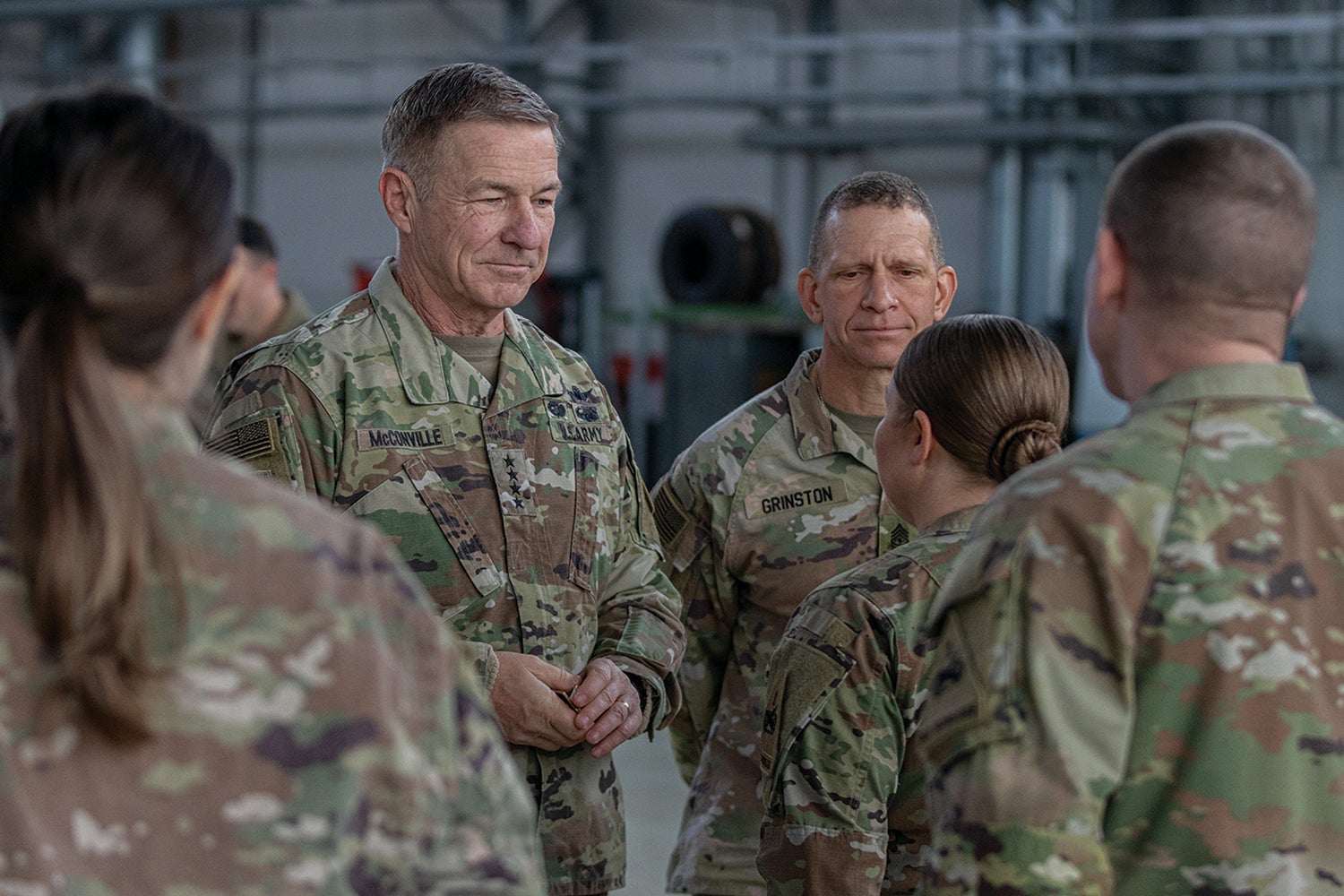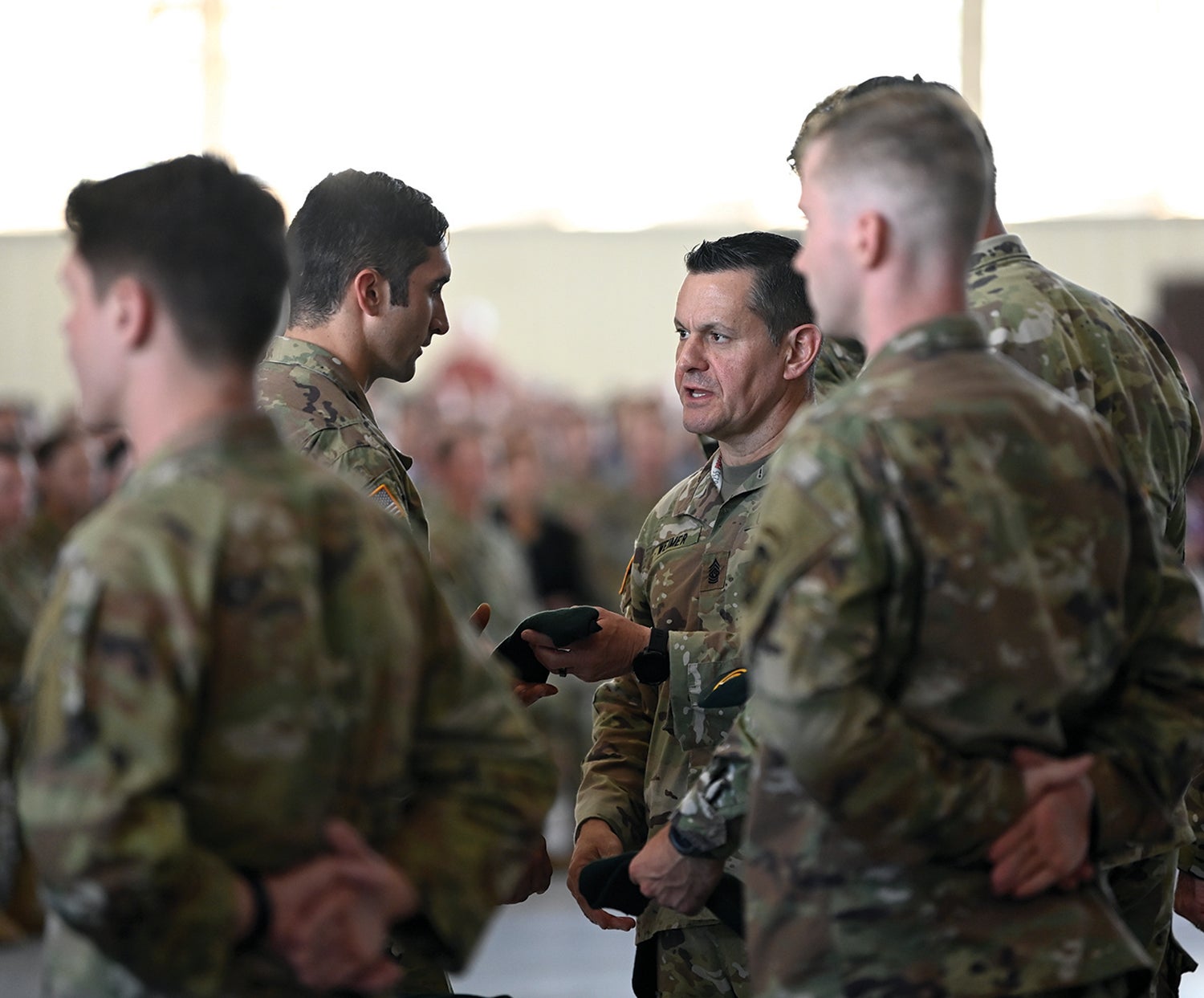When the 17th sergeant major of the Army is sworn in in August, he will be the first in the Army’s history to have earned the job by going through a tough new assessment and selection program.
Senior nominative sergeants major competing for the Army’s top enlisted position have always been evaluated with a physical fitness test, a review of their enlisted record brief, a letter of recommendation from their current commanding general and high-level interviews.
Those elements are still part of the new assessment program, but this time, candidates also were evaluated on written and oral communication skills, psychological and cognitive fitness, performance in the new Army Combat Fitness Test and ability to adapt and respond to the unexpected.
“It’s the first time it’s ever been done this way,” said Sgt. Maj. of the Army Michael Grinston, who is slated to retire and be succeeded by Sgt. Maj. Michael Weimer on Aug. 4. “It’s the most comprehensive assessment we’ve ever done on anybody since I’ve been in the Army.”

Broader Approach
In early 2022, as he considered his successor’s selection, Grinston concluded that the evaluation process needed a broader approach than when he was selected, to include some of the white-knuckle situations he’d been in since starting the job in August 2019.
He felt the process should be data-driven and objective so when the last candidates reached the high-level boards and, ultimately, an interview with the Army chief of staff, an informed decision could be made based on a multifaceted assessment.
“My thought process was, how do you lead an organization through talent management and assessments if you’ve never gone through an assessment?” Grinston said, suggesting he could be labeled “hypocritical” because, while he made the cut to get the top enlisted job, “I didn’t do a full assessment to be sergeant major of the Army” because there wasn’t one.
Under Grinston’s guidance, the basic program was modeled after portions of the U.S. Army Command Assessment Program, the four-day assessments that have been carried out since 2020 at Fort Knox, Kentucky, for officers competing for command of a battalion or brigade and, more recently, sergeants major competing for senior enlisted positions.

Grinston also incorporated a mock congressional hearing and grilling by journalists, two regular occurrences in a uniquely high-visibility job for which there is little or no prep time.
Army Chief of Staff Gen. James McConville in December announced that Weimer had been selected to be the 17th sergeant major of the Army. Weimer, who most recently was senior enlisted adviser for the U.S. Army Special Operations Command, said the assessment was “a well-done event, a positive experience.” Weimer predicted he “will absolutely look to sustain it for whenever they decide to replace me.”
“This [assessment] speaks volumes to the authenticity of the selection process, and it also speaks to the force to say, ‘Hey, we’re doing this for battalion commanders, for brigade commanders, for command sergeants major at the brigade level, and the [sergeant major of the Army] position is so important, we’re going to do it for that,’” Weimer said. “I think it’s a great message to the force.”
Weimer relinquished his responsibilities at Army Special Operations Command on May 1 for his family’s move to the Washington, D.C., area and to prepare for his new position.
Unbiased Setting
Designed by the Army Talent Management Task Force at Grinston’s request, the special assessment program, cryptically named “Cohort X,” took place in mid-September at the U.S. Military Academy at West Point, New York. Away from the prying eyes on a regular Army post “where everybody knows everybody,” Grinston said, the task force was able to quietly enlist the help of “unbiased folks” at West Point.
The program was pieced together using elements of the Command Assessment Program. Events such as leader reaction and team-building exercises were excluded because Grinston didn’t think they would be essential assessments at the highest level.
Instead, a mock congressional hearing and press event, which were designed to be stress-inducing, presented “observed behavior” opportunities that could be assessed from multiple angles, said Col. Townley Hedrick, the task force’s chief of staff for the Command Assessment Program and lead project officer for Cohort X.
Command Sgt. Maj. Phelicea Redd, the task force’s senior enlisted adviser, said the two stress events were the types of engagements the next sergeant major of the Army likely “won’t be prepared for right away” and would offer the most realistic experiences.
Volunteers from West Point’s faculty, staff and cadet corps helped manage logistics, grade writing, conduct double-blind interviews, assess psychological and cognitive abilities and conduct mock congressional hearings followed by media roundtables.
Many events took place in the academy’s multistory library, where the task force set up a command center and monitored movements. In another room, graders, raters and observers tallied scores and reported the results of the tests.
The congressional hearing and the media roundtable events took place in the cavernous rooms of Thayer Hall, one of West Point’s most iconic Gothic Revival-style buildings. This provided the “wow factor” needed to replicate the potentially intimidating environment on Capitol Hill, Hedrick said.

Eye-Opening Events
During the assessment, the 14 candidates for sergeant major of the Army stayed in an off-campus hotel. They were shuttled back and forth individually over three days at staggered start times for scheduled events in different uniforms.
After height and weight measurements and the Army Combat Fitness Test, candidates were interviewed by operational psychologists, then given a timed writing assignment in which they had to brief the Army chief of staff on five of the Army’s priorities in a mock email.
Following a short prep session with Army public affairs officers who provided coaching on messaging and authenticity, the candidates had the night to study hundreds of pages for the next day’s mock hearing, an elaborate event orchestrated by the Army’s legislative liaison office.
The hearing was so realistic that many candidates faltered, giggled nervously or even fell silent under the questioning by role-players from the academy’s Law Department.
With the unexpectedly bruising event behind them, the candidates were then surprised to be walked right into a 15-minute media roundtable.
“When they walked me down the hall and said, ‘Hey, you’re not done; we still have the media roundtable,’ I was like, ‘Oh no!’” said Command Sgt. Maj. Steve Helton, the senior enlisted adviser at the U.S. Army Combined Arms Center and one of the sergeant major of the Army candidates. “From an assessment perspective, that was striking. It was really good because I had to very quickly mentally reset.”
Weimer noted that, as a decadeslong member of the special operations community in which soldiers undergo multiple assessments and assess others, he was comfortable with some of the assessment’s physical and psychological aspects. He also didn’t worry about the writing assignments because “I’m going to write how I write at this point in my career,” he said.
But the congressional testimony session, which lasted 30 minutes, had him reacting by the seat of his pants. It gave him a true appreciation for what Grinston has been doing on the job, Weimer said. “There were physical manifestations of nerves that you had to control to be able to perform,” he said, admitting that he worked to maintain his heart rate and breathing, and was reluctant to take a sip from the glass of water in front of him for fear of showing a shaking hand.
“That was real stuff I absolutely loved,” Weimer said. “I won’t speak for any of my peers, but that was a pretty big eye-opener for a few of them. They were like, ‘Yeah, I’m not really interested in ever doing this again.’”
Critical Feedback
Though only three candidates made it to McConville’s office for the final interview, all 14 candidates received an outbrief with Grinston and members of the task force.
The outbrief was one of the most valuable parts of the assessment, Helton said. “Even though I didn’t get the job, the feedback I got has helped me validate some things I already know about myself and continue to work on areas that I know need improvement,” he said. “Because I’m still in the Army, I still have a job, and that feedback piece was critical.”
Sgt. Maj. Steve McDonald, the task force’s enlisted talent management team lead and the Cohort X coordinator and liaison between the task force and Grinston, said the group of candidates was “a tight-knit group” who all knew each other well and provided “generally positive” feedback on the first-time assessment.
“They loved it,” he said, even the unexpected hearing and press event. “Once we told them [about the two events], a lot of them went on YouTube to watch some of Grinston’s old testimony, so they used some resources they had without giving away information, and for the most part they really enjoyed getting looked at differently.”
Once the Cohort X event was behind them, McDonald said, members of the task force and other participants enjoyed a “sense of accomplishment on the work we did and how we are helping the Army in the long run.”
McConville, who also is slated to retire in August after a four-year term as Army chief of staff, said he was “very satisfied” with the assessment. He described it as fair and transparent, and a process that should be used for the Army’s top leaders in the future.
Soldiers “want a sergeant major of the Army they can be proud of,” McConville said.
“Having a rigorous process and making sure the sergeant major of the Army has the knowledge, skills and behaviors to serve in that position is extremely important, and I think this [assessment] will become the norm,” McConville said.
Editor’s Note: The author of this article had a minor role in the new sergeant major of the Army selection process. At the invitation of the Army Talent Management Task Force, she participated in the mock media roundtable and graded candidates on how they responded.

